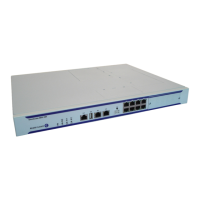VPLS Features
Page 344 7750 SR OS Services Guide
The system maintains a unique flooding list for each forwarding plane VPLS context (see section
VPLS Broadcast/Multicast/Unknown Flooding List on page 344). This list will contain all SAPs
(except for residential SAPs), spoke SDP and mesh SDP bindings on the forwarding plane that
belong to that VPLS context. Each list may contain a maximum of 127 SAPs. In the case where
the IOM is able to create an egress multicast chain, the SAPs within the chain are represented in
the flooding list by a single SAP entry (the first SAP in the chain).
The system also maintains a unique flooding list for each Layer 2 IP multicast (s,g) record created
through IGMP snooping (see sections VPLS IGMP Snooping (s,g) Flooding List on page 345 and
MVR IGMP Snooping (s,g) Flooding List on page 345). A flooding list created by IGMP
snooping is limited to 127 SAPs, although it may contain other entries representing spoke and
mesh SDP bindings. Unlike a VPLS flooding list, a residential SAP may be included in a Layer 2
IP multicast flooding list.
While the system may allow 30 SAPs in a chain, the uninterrupted replication to 30 destinations
may have a negative effect on other packets waiting to be processed by the egress forwarding
plane. Most notably, massive jitter may be seen on real time VoIP or other time-sensitive
applications. The dest-chain-limit parameter should be tuned to allow the proper balance between
multicast replication efficiency and the effect on time sensitive application performance. It is
expected that the optimum performance for the egress forwarding plane will be found at around 16
SAPs per chain.
VPLS Broadcast/Multicast/Unknown Flooding List
The IOM includes all VPLS destinations in the egress VPLS Broadcast/Multicast/Unknown
(BMU) flooding list that exist on a single VPLS context. Whenever a broadcast, multicast or
unknown destination MAC is received in the VPLS, the BMU flooding list is used to flood the
packet to all destinations. For normal flooding, care is taken at egress to ensure that the packet is
not sent back to the source of the packet. Also, if the packet is associated with a split horizon group
(mesh or spoke/SAP) the egress forwarding plane will prevent the packet from reaching
destinations in the same split horizon context as the source SAP or SDP-binding.
The VPLS BMU flooding list may contain both egress multicast group SAPs and other SAPs or
SDP bindings as destinations. The egress IOM will separate the egress multicast group SAPs from
the other destinations to create one or more chains. Egress multicast group SAPs are placed into a
chain completely at the discretion of the IOM and the order of SAPs in the list will be
nondeterministic. When more SAPs exist on the VPLS context within the egress multicast group
then are allowed in a single chain, multiple SAP chains will be created. The IOM VPLS egress
BMU flooding list will then contain the first SAP in each chain plus all other VPLS destinations.
The SAPs in the same VPLS context must be in the same split horizon group to allow membership
into the egress multicast group. The split horizon context is not required to be the same between
VPLS contexts.
SAPs within the same VPLS context may be defined in different egress multicast groups, but
SAPs in different multicast groups cannot share the same chain.

